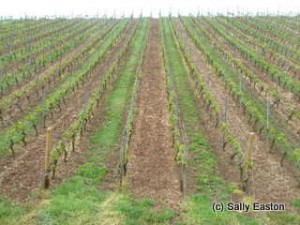Germany 2009 Weingut Gunderloch
Vintage 2009 is a startlingly super riesling vintage, if a recent tasting of wines in Germany is anything to go by.
A combination of ripeness with retained, relatively high acidity are cited as the defining parameters of the 2009 in the main riesling regions of Mosel, Rheingau, Nahe, Pfalz and the Rheinhessen. This was defined as a year of long ripening and good structure. But volumes are down across the board.
Some have said 2009 is as good as 2007. By comparison 2008 was not so warm, on average. There is enough ripeness in 2008 but the acidity is crispier and more pronounced. The wines are perhaps less concentrated than the 2009s.

Fritz Hasselbach in the Rothenberg
Weingut Gunderloch is located at Nackenheim in the Rheinhessen and is run by Fritz and Agnes Hasselbach.
Rheinhessen is the biggest German wine region, accounting for a quarter of the country’s vineyard, and it is the small, six kilometre by ~1 km Rheinterrasse, an east and south-east facing slope on the left bank of the river Rhine, some 10 km south of Mainz, where some of the best quality is found.
Nackenheimer Rothenberg, made up of red slate, is one of the prime vineyards on the Rheinterrasse, and Gunderloch own more than three quarters of this named vineyard, 9.5ha out of the property’s total vineyard acreage of 14 hectares.
Other top vineyards on the Hessen Rheintarrasse include Pettenthal, Hipping, Ölberg and Orbel.
Riesling is one of a couple of handfuls of grape varieties grown in Rheinhessen, accounting for about 15% of the region’s production. Yet at Gundlerloch, riesling is something of a specialty, accounting for 80% of production, with silvaner, pinot gris, pinot blanc and traminer among the rest.
Fritz and Agnes Hasselbach have been running the family winery since 1986, and their children Kathrin, Johannes and Stefanie are also part of the team.
For dry wines, three levels are made at this estate: the estate dry, the village dry, and grosses gewächs. Fruity wines follow the normal designations.
In 2009, Gunderloch made no beerenauslese or trockenbeerenauslese because wild boars and birds ate all the grapes, despite the vines have protective netting over them. The family lost a hectare of grapes.

Rothenberg vineyard
Fritz is experimenting with malolactic fermentation on riesling, which is usually unheard of for this variety. He said “malo gives more weight in the taste, which is a secret of Hessen”, adding “in the past the balance was from residual sugar, but in the new style the balance is with malo.” Exacting control is essential though as malo can change pure fruity flavours into more creamy, less aromatic notes. He said they have strict temperature control, and they “check every day. As soon as we get a creamy note, we chill to kill the yeast and the malolactic bacteria.”
Read here for a review of the 2009 rieslings from Weingut Hermann Dönnhoff in the Nahe.
Read here for a review of the 2009 rieslings from JL Wolf in the Pfalz.
Tasting notes, in situ, April 2010
2009 Estate Riesling dry
12.5%. 8 g/l RS, 8g/l TA. A blend of 5 different vineyards sites, all with red slate.
Lemon grass, fresh, lifted, racy acidity, warmth of lemon citrus at finish.
2009 Nierstein Village Riesling dry
12.5%. 6g/l RS.
Lemon grass, and gunsmoke, perceptibly off dry attack, with softness and richness in the mid palate added by small proportion of malolactic fermentation. Good length.
2009 Nackenheim Village Riesling dry,
12.5%. Rothenberg single vineyard.
Lemongrass, citrus, melon, supple mid palate offered by small proportion of malolactic again. Nice limey element to acidity. Approachable yet young, with plenty to unfurl.
2009 Gunderloch Jean Baptiste Riesling Kabinett
11%. 24g/l RS. 7.5g/l TA. Usually a mix of Rothenberg and Pettenthal vineyards
Lemon citrus, off dry fruity attack, with near-dry palate perception. Apple, nice balance, with good fruit purity. Refreshing, elegant, easily drinkable.
2009 Nackenheim Rothenberg Riesling Spatlese
9.5%. 90 g/l RS. 7.5g/l TA. Without botrytis, it is the Gunderloch philosophy.
Limey, sweet attack of fresh apricot and white peach. This comes back to racy, sharp balancing acidity. Lush, intense, explosive citrus and early tropical fruits. Mouth-watering freshness, but with some intensity of svelte power. Long finish.
2009 Nackenheim Rothenberg Riesling Auslese
7.5%. 110g/l RS. 100% botrytis wine.
Citrus, intense, lime, explosive, pure, sweet, Massive flavours, pure and long.
2009 Nackenheim Rothenberg Riesling Auslese Goldkapsel
8%. 130-140g/l RS. Fritz said this is always in beerenauslese style, but an easy-drinking style.
Spicy aromatics, mango and yellow tropical, full and honeyed, elegant with well-toned power and presence. Elegant and too easy to drink.
The UK agents, ABS Wine Agencies, flew me, and a group of UK importers, to Germany to taste the 2009s from the producers they represent.
Comments
One Response to “Germany 2009 Weingut Gunderloch”




January 5, 2013 at 12:34 pm
I found the article informative and the compassion of Fritz Hasselbach for his products and care in regard to soil type and temperature control. Would I be able to send a bottle to friends nearby in Wachenheim..or they could ‘pop over’ Thanks
Iain